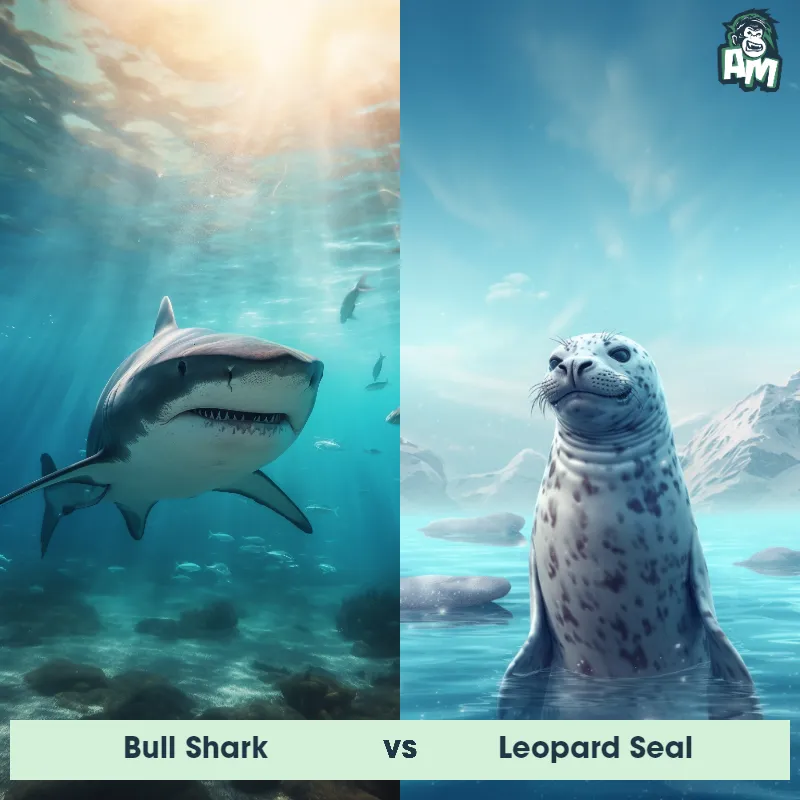Bull Shark vs Leopard SealSee Who Wins

Ladies and gentlemen, welcome to this thrilling matchup between two fierce competitors in the animal kingdom! In one corner, we have the powerful Bull Shark, known for its brute strength and relentless aggression. And in the other corner, we have the cunning Leopard Seal, known for its agility and deadly precision. This fight is bound to keep us on the edge of our seats. Let's get ready to witness the ultimate battle of nature's titans!
Contender 1: Bull Shark
The Bull Shark, also known as the Zambezi Shark, is a large predatory fish found in warm coastal waters and freshwater rivers around the world. They are known for their aggressive behavior and ability to tolerate freshwater, allowing them to swim far up rivers. Bull Sharks have a stocky build, with a grey or brownish coloration and a short, broad snout filled with sharp teeth. They can grow up to 11 feet long and weigh over 500 pounds.
Fun Fact: Bull Sharks are known for their ability to swim in freshwater rivers, and have been found as far up the Mississippi River as Illinois.
Contender 2: Leopard Seal
The Leopard Seal, also known as Hydrurga leptonyx, is a large and powerful marine mammal that can be found in the frigid waters surrounding Antarctica. They are easily recognizable by their spotted coat, which is dark gray or black with lighter spots. Leopard Seals have a long, sleek body and a large head with powerful jaws filled with sharp teeth. They are known for their impressive hunting skills and are apex predators in their ecosystem, feeding on a variety of prey including fish, squid, and other seals.
Fun Fact: Leopard Seals are known for their unique vocalizations, which include grunts, growls, and eerie wails that can be heard underwater for long distances.
Matchup Stats
| Bull Shark | Leopard Seal | |
|---|---|---|
| Size | Up to 11 feet (3.4 meters) | Up to 11 feet (3.3 meters) in length |
| Weight | Over 500 pounds (227 kilograms) | Up to 1,300 pounds (590 kilograms) |
| Speed | Speed: 25 mph (40 km/hr) | Speed: 25 mph (40 km/hr) |
| Key Strength | Powerful bite force and aggressive behavior | Powerful jaws and sharp teeth |
| Biggest Weakness | Vulnerable to attacks on the gills and eyes | None noted |
Current Votes
Bull Shark vs Leopard Seal
See Who Wins
View More Matches
Looking For More?
Similar Matches
Scientific Stats
| Bull Shark | Leopard Seal | |
|---|---|---|
| Scientific Name | Carcharhinus leucas | Hydrurga leptonyx |
| Family | Carcharhinidae | Phocidae |
| Habitat | Warm coastal waters and freshwater rivers | Marine |
| Geography | Found worldwide in tropical and subtropical regions | Antarctic waters |
| Diet | Carnivorous, feeding on fish, dolphins, turtles, and other sharks | Fish, squid, and other seals |
| Lifespan | 12 years - 16 years | 12 years - 15 years |
Key Differences between Bull Shark and Leopard Seal
- Teeth: Bull sharks possess serrated, triangular-shaped teeth designed for capturing and slicing prey, while Leopard seals have strong, non-serrated canines that allow them to grip and crush their prey.
- Coloration: Bull sharks exhibit a uniform gray or gray-brown coloration on their dorsal side, while Leopard seals have a distinct spotted or mottled pattern consisting of dark gray or black spots on their lighter gray or silver body.
- Tail Shape: Bull sharks have a downward-curving, crescent-shaped tail fin, which aids in rapid acceleration and maneuvering, while Leopard seals have a more horizontally oriented, paddle-like tail fin that assists them in swimming long distances.
- Body Shape: Bull sharks possess a stout body with a broad and stocky appearance, while Leopard seals have a more elongated, streamlined body with a tapering shape toward the rear.
- Size: Bull sharks (Carcharhinus leucas) typically reach a maximum length of around 11 feet, whereas Leopard seals (Hydrurga leptonyx) can grow up to 11.5 feet in length.
- Dorsal Fins: Bull sharks have two dorsal fins, with their first dorsal fin being larger and more triangular-shaped, whereas Leopard seals have only one dorsal fin, which is less pronounced and more curving in shape.
































